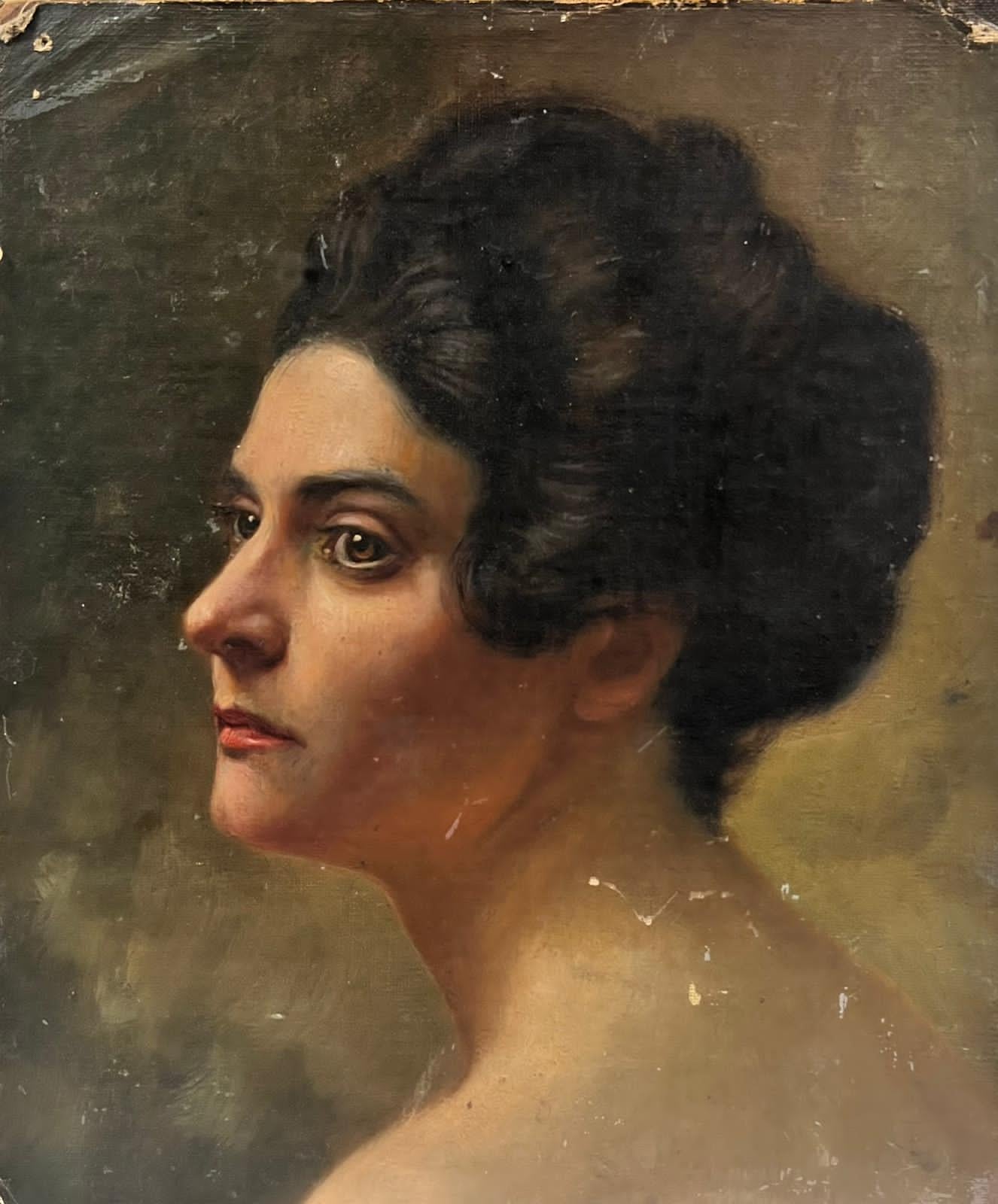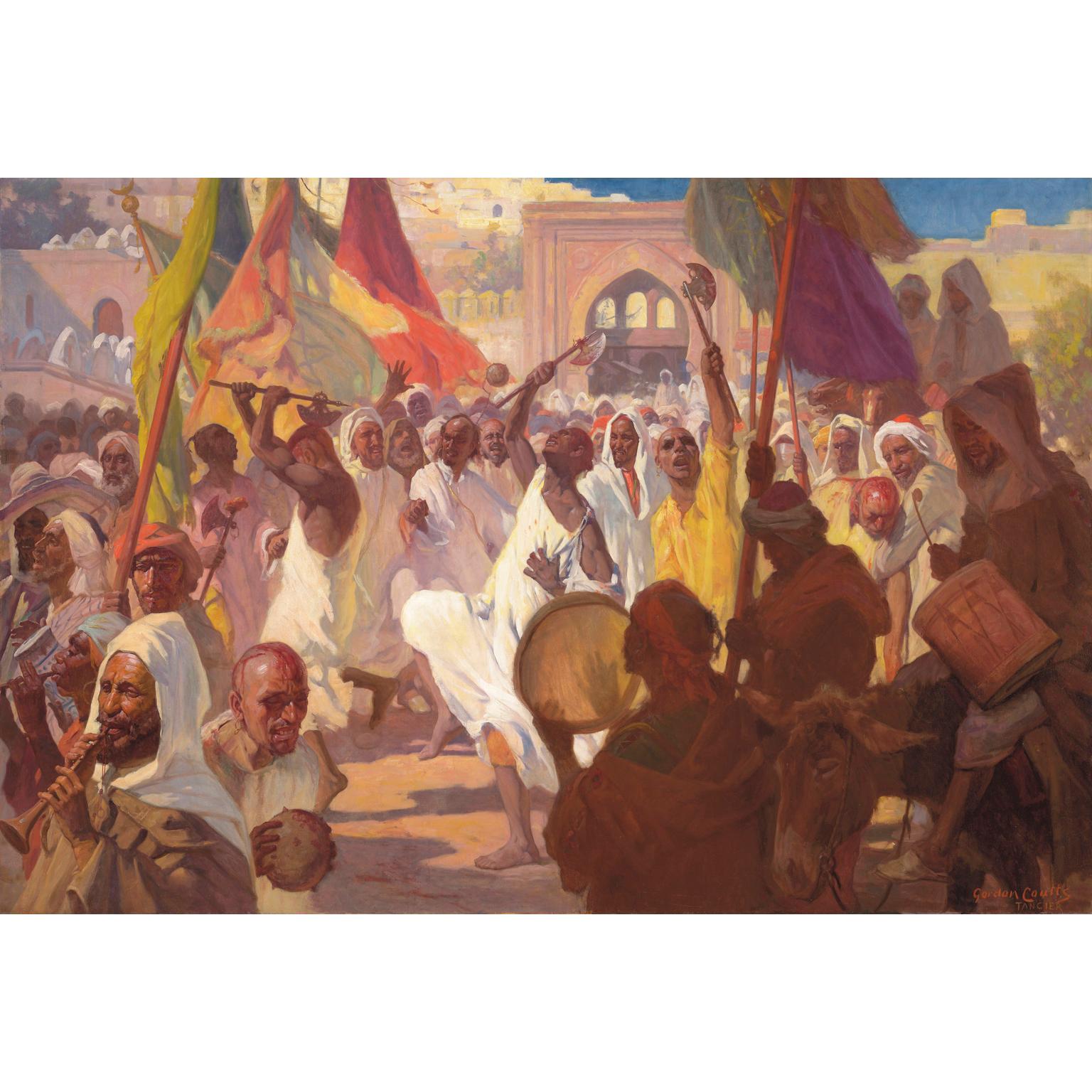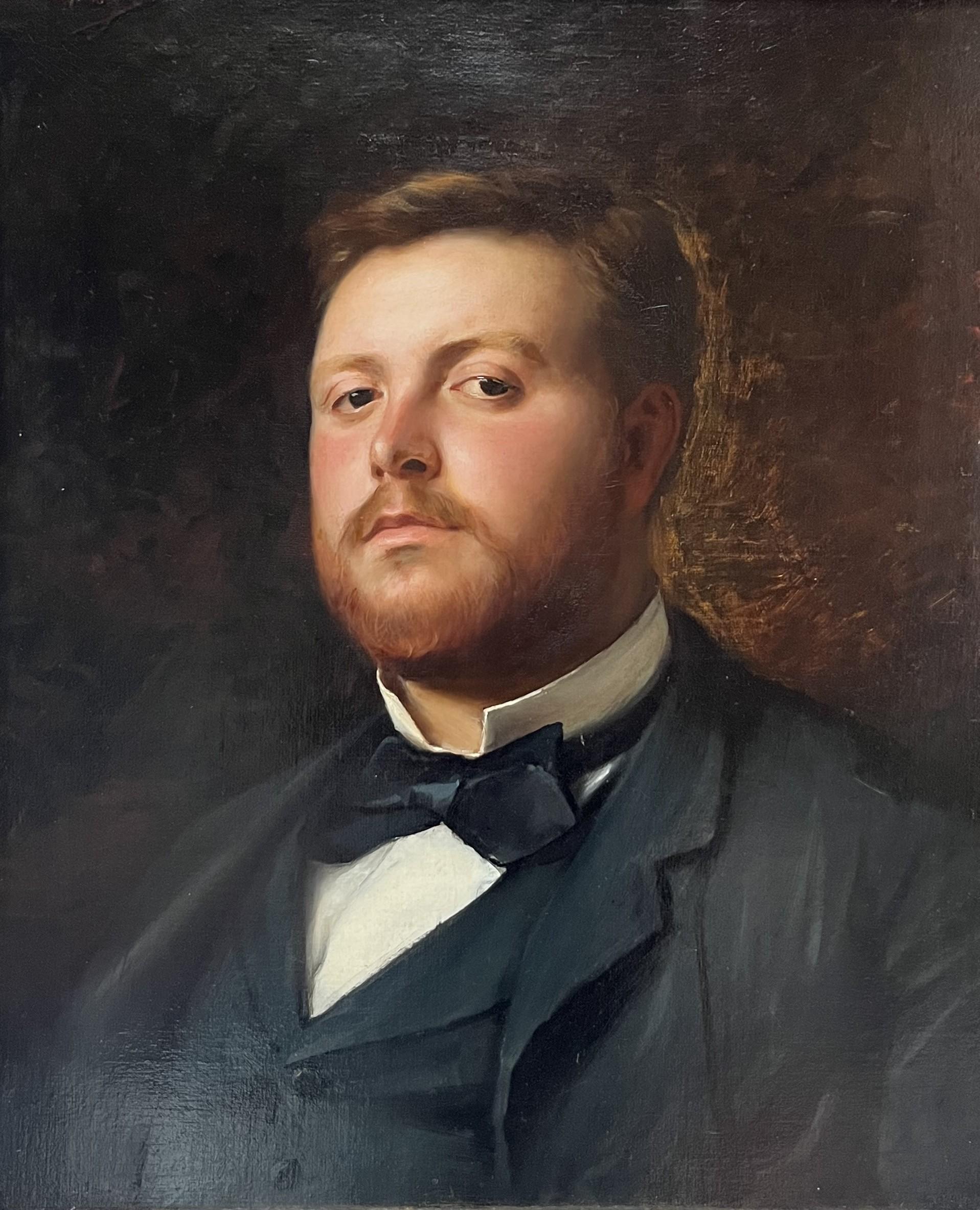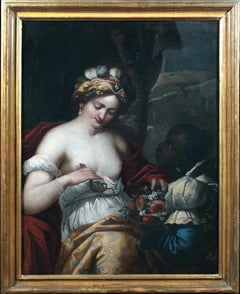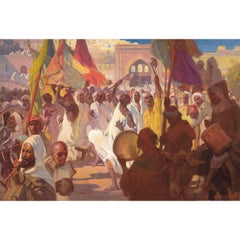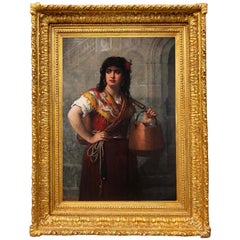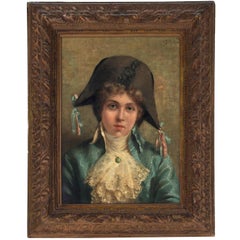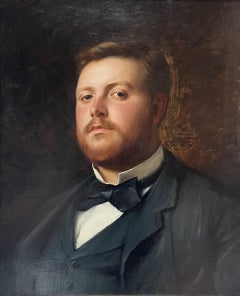Items Similar to Portrait Painting Oil on Canvas by Joseph Badger
Want more images or videos?
Request additional images or videos from the seller
1 of 12
Joseph BadgerPortrait Painting Oil on Canvas by Joseph Badger1750
1750
On Hold
$27,632.77
On Hold
£20,235.64
On Hold
€23,000
On Hold
CA$37,615.11
On Hold
A$42,161.69
On Hold
CHF 21,952.36
On Hold
MX$514,812.31
On Hold
NOK 278,715.16
On Hold
SEK 264,196.91
On Hold
DKK 175,037.01
Shipping
Retrieving quote...The 1stDibs Promise:
Authenticity Guarantee,
Money-Back Guarantee,
24-Hour Cancellation
About the Item
Joseph Badger (c. 1707–1765) was a portrait artist in Boston, Massachusetts, in the 18th century.
This amazing painting depicting a young boy with a bird.
oil on canvas cm 93 x73
Finely carved gilt wood frame . cm 105 x85
Joseph Badger began his career as a house painter-glazier and expanded his business to include portraiture. He was a Boston artist who made portraits of subjects in such nearby towns as Brookline, Charlestown, and Milton. How he learned to paint remains a matter of speculation, although several art historians have suggested John Smibert as an early influence and John Singleton Copley as a late one. Badger’s consistent use of an underpainting supports the theory that he received some training; those same cool, preliminary tones are now visible through abraded paint layers and have led some commentators to pronounce his subjects "wraithlike." At least 150 portraits are either extant or known to have been executed between 1743 and 1765. Badger has been described as a folk painter and an artisan painter, designations that suggest both his limitations as an artist and his natural abilities. His small repertoire of poses and formats facilitated the identification of his uniformly unsigned canvases. Like other eighteenth-century American painters, ranging from anonymous overmantel artists to the fashionable Copley, Joseph Badger depended upon imported English prints as sources for his compositions. More than one-third of his surviving paintings depict children, who are often represented with a pet bird, squirrel, or dog or, in the case of toddlers, holding a rattle. His portraits were created in a distinctive linear style, often with awkward proportions and little modeling. Despite these limitations, Badger was able to achieve specific likenesses of his sitters.
Badger was born on March 14, 1707/8 in Charlestown, Massachusetts, the sixth of nine children of Mercy Kettell and Stephen Badger, a tailor. On June 2, 1731, Joseph married Katharine Felch in Cambridge, and the couple had between six and nine children.2 At least two of the Badgers’ sons, Joseph and William, became painters and glaziers like their father. (Moving to Charleston, South Carolina, shortly after their father’s death in 1765, the brothers announced that they had "just arrived from Boston, in New-England, and propose to carry on their business of painting and glazing in all their branches.")3 Another artist in the Badger family was Daniel, perhaps one of Joseph’s brothers, who moved to Charleston about 1735 and advertised that he "undertakes and compleats all sorts of House and Ship paintings."4
The young Badger family moved to Boston about 1733, settling in the neighborhood of Brattle Street and attending the Brattle Square Church, where four of Joseph and Katharine’s children were baptized. Joseph’s patrons included the colleague pastor of the church, the Reverend William Cooper (about 1743, Massachusetts Historical Society, Boston) and a number of parishioners, including John Larrabee.5
The Brattle Street (now Franklin Street) neighborhood was home to several painters and other artisans, including John Singleton Copley, John Greenwood, Peter Pelham, and John Smibert. The Scottish-born Smibert (1688–1751) emigrated from London in 1728 and introduced the baroque Lely-Kneller portrait tradition to the northern colonies. He established a studio in Boston on Queen Street (now Court Street), a block from the church where the Badger children were baptized. Smibert also ran a shop that would have given Badger access to "all Sorts of Colours, dry or ground, with Oils and Brushes, Fans of several Sorts, the best Mezzotinto. Italian, French, Dutch and English Prints, in Frames and Glasses, or without, by Wholesale or Retail at reasonable Rates."6
Whether Badger received instruction from Smibert cannot be determined, although his work does reflect knowledge of the British artist’s paintings. Smibert’s shop also may have provided the English prints that served as sources for Badger’s portraits. The importance of prints to Badger’s development as an artist is widely evident. For instance, Thomas Cushing (about 1745, Peabody Essex Museum, Salem, Massachusetts) and Cornelius (1750) and Faith Waldo (about 1750) are alike depicted in high-backed chairs in poses borrowed from an English mezzotint of Sir Isaac Newton by John Faber (1725, after John Vanderbank). Smibert, too, used this print as a source for his portrait of Daniel Oliver (1732, private collection).7 Smibert’s failing eyesight and health in the mid-1740s and his death in 1751 left a gap in the Boston portrait market that Badger filled until the arrival of Joseph Blackburn in 1755 and the emergence of Copley as an artistic force shortly thereafter. Badger continued to paint during the last decade of his life.
Also in the Brattle Street neighborhood was Thomas Johnston (1708–1767), a versatile artist who painted portraits and coats of arms; japanned and painted furniture; engraved maps, music, bookplates, and clock faces; and cut gravestones. Johnston lived on Ann Street, east of Brattle Square.8 He trained John Greenwood (1727–1792), who was his apprentice from 1741 to 1745. Johnston was active in the Brattle Square Church, so it is very likely that the two knew each other. Like Smibert, Johnston sold artists’ materials. Indeed, the extant account books of Daniel Rea I, later Johnston’s business partner, identify Badger as a customer in 1751 and 1752. He was credited for a picture and for decorating buckets, items that were then probably resold to a third party, and he was charged for a hat and sundries.
References
Lawrence Park. Joseph Badger (1708-1765): and a descriptive list of some of his works. 1918
Boston Evening Post, 05-13-1765; p.3., center column, roughly ⅔ down
Meschutt, David (July 2004). Park, Lawrence (1873-1924), art historian. New York: Oxford University Press. doi:10.1093/anb/9780198606697.article.1401139.
Yale Bulletin Archived 2009-04-18 at the Wayback Machine. 2003
Smithsonian
Worcester Art Museum
Joseph Badger and His Work, Proceedings of the Massachusetts Historical Society, Volume 51, Massachusetts HIstorical Society, Published by the Society, Boston, Massachusetts, 1918
In the portrait of Rebecca Orne as a child in the Worcester Art Museum, the sitter holds a squirrel. Badger incorporated an emblematic squirrel into some of his portraits; he "would seem to have the claim to primacy" of what later became a hot trend in colonial portraiture, common in the work of his contemporary John Singleton Copley. Cf. Roland E. Fleischer. Emblems and Colonial American Painting. American Art Journal, Vol. 20, No. 3 (1988); p.26
Susan Rather. Carpenter, Tailor, Shoemaker, Artist: Copley and Portrait Painting around 1770. Art Bulletin, v.79, No. 2, June 1997; p.288
Museum of Fine Arts, Boston
Massachusetts Historical Society. "Smith-Townsend Family Papers and Papers II".
Portrait of Whitefield, ca. 1750, attributed to Joseph Badger. Harvard University Portrait Collection.
- Creator:Joseph Badger (1708 - 1765, American)
- Creation Year:1750
- Dimensions:Height: 41.34 in (105 cm)Width: 33.86 in (86 cm)Depth: 1.97 in (5 cm)
- Medium:
- Movement & Style:
- Period:
- Condition:
- Gallery Location:Rome, IT
- Reference Number:1stDibs: LU1004114155802
About the Seller
5.0
Vetted Professional Seller
Every seller passes strict standards for authenticity and reliability
1stDibs seller since 2018
32 sales on 1stDibs
Typical response time: 2 hours
- ShippingRetrieving quote...Shipping from: roma, Italy
- Return Policy
Authenticity Guarantee
In the unlikely event there’s an issue with an item’s authenticity, contact us within 1 year for a full refund. DetailsMoney-Back Guarantee
If your item is not as described, is damaged in transit, or does not arrive, contact us within 7 days for a full refund. Details24-Hour Cancellation
You have a 24-hour grace period in which to reconsider your purchase, with no questions asked.Vetted Professional Sellers
Our world-class sellers must adhere to strict standards for service and quality, maintaining the integrity of our listings.Price-Match Guarantee
If you find that a seller listed the same item for a lower price elsewhere, we’ll match it.Trusted Global Delivery
Our best-in-class carrier network provides specialized shipping options worldwide, including custom delivery.More From This Seller
View AllCleopatra Queen of Egypt 17' century Painting Oil on Canvas
Located in Rome, IT
Amazing painting of Cleopatra oil on canvas with a gilt wood frame.
Attributed to Giuseppe Diamantini (Fossombrone 1621-Venice 1705)
The dramatic subje...
Category
Late 17th Century Academic Figurative Paintings
Materials
Oil
Cleopatra Queen of Egypt 17' century Painting Oil on Canvas
Located in Rome, IT
Amazing painting of Cleopatra oil on canvas with a gilt wood frame.
Attributed to Giuseppe Diamantini (Fossombrone 1621-Venice 1705)
The dramatic subje...
Category
Late 17th Century Academic Figurative Paintings
Materials
Oil
Cleopatra Queen of Egypt 17' century Painting Oil on Canvas
Located in Rome, IT
Amazing painting of Cleopatra oil on canvas with a gilt wood frame.
Attributed to Giuseppe Diamantini (Fossombrone 1621-Venice 1705)
The dramatic subje...
Category
Late 17th Century Academic Figurative Paintings
Materials
Oil
Cleopatra Queen of Egypt 17' century Painting Oil on Canvas
Located in Rome, IT
Amazing painting of Cleopatra oil on canvas with a gilt wood frame.
Attributed to Giuseppe Diamantini (Fossombrone 1621-Venice 1705)
The dramatic subje...
Category
Late 17th Century Academic Figurative Paintings
Materials
Oil
Cleopatra Queen of Egypt 17' century Painting Oil on Canvas
Located in Rome, IT
Amazing painting of Cleopatra oil on canvas with a gilt wood frame.
Attributed to Giuseppe Diamantini (Fossombrone 1621-Venice 1705)
The dramat...
Category
Late 17th Century Academic Figurative Paintings
Materials
Oil
Graceful Portrait of the Countess Carrobio Pastel on Canvas 1910 circa
By Carl Froschl
Located in Rome, IT
Graceful Portrait of the Countess Carrobio with elegant white dress. Pastel on Canvas with finely carved gilt wood frame.
Signed CFroschl .
Carl Forsche 1848- 1934 . Austrian Painte...
Category
Early 20th Century Art Nouveau Figurative Paintings
Materials
Pastel
You May Also Like
A Very Fine and Large Oil on Canvas "Ashura Rituals in Tangier, Morocco"
Located in LA, CA
Gordon B. Coutts (Scottish/American, 1868-1937) A very fine and large orientalist oil on canvas titled "Ashura Rituals, Tangier" (Arabic: عاشوراء ʻĀshūrā’ - Urdu: عاشورا - Persian:...
Category
Early 20th Century Academic Figurative Paintings
Materials
Oil
Large & Impressive French 19th Century Oil on Canvas "The Water Carrier Lady"
By Jules Salles-Wagner
Located in LA, CA
Jules Salles-Wagner (French, 1814-1898) A Large and Impressive French, 19th century oil on canvas "The Water Carrier Lady" depicting a standing and posing young peasant girl holding ...
Category
19th Century Academic Figurative Paintings
Materials
Oil
A Fine Italian 19th Century Oil on Canvas "A Young Man Napoleonic Bicorne Hat".
Located in LA, CA
Napoleone Luigi Grady (Italian, 1860-1949) A Very Fine Oil on Canvas "A Young Man Bicorne Hat". The beautifully executed artwork depicting a posing young boy in full period celebrato...
Category
Late 19th Century Academic Portrait Paintings
Materials
Oil
J. Bonnevay, Portrait of a Gentleman, oil on canvas signed
Located in Paris, FR
J. Bonnevay (active in France in the late 19th century)
Portrait of a Gentleman
Signed upper left
(the signature is quite difficult to read, but without a doubt Bonnevay's)
Oil on c...
Category
1890s Academic Portrait Paintings
Materials
Oil
Current, Oil Painting
By Elizabeth Zanzinger
Located in Denver, CO
Elizabeth Zanzinger's (US based) "Current" is an oil painting that depicts a lone figure in a golden field with clouds holding a floral fabric agai...
Category
2010s Academic Figurative Paintings
Materials
Oil
"Crossing", Oil Painting
By Elizabeth Zanzinger
Located in Denver, CO
Elizabeth Zanzinger's (US based) "Crossing" is an oil painting that depicts an elderly man crossing the high water of a river with a young child on...
Category
2010s Academic Figurative Paintings
Materials
Oil, Panel
More Ways To Browse
Male Old Master Portraits
Queen Anne Oil Painting
18th Century Female Portraits
Lady Barbara
Regal Oil Portrait
18th Century Of Female Portraits
Van Loo
17th Century Portrait Of A Gentleman
James Coates Fine Art
Original 19th C Portrait Of Black
19th Century Male Portrait French
George Vertue
William Henry Earl
Winston Churchill Paintings
Barbara Doyle
Bourlet Frame
Guido Reni Oil Painting
John Riley
